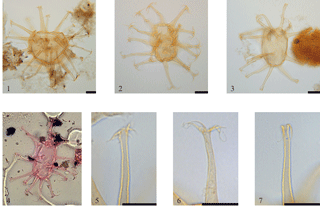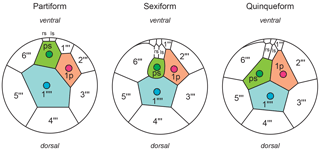Fetchamium prolixispinosum gen. et comb. nov. (division Dinoflagellata)
Oligosphaeridium is a gonyaulacacean dinocyst lacking cingular processes and possessing a distinctive process centred on the antapical plate indicating a sexiform hyposomal tabulation. However, specimens referable to the description of Oligosphaeridium prolixispinosum Davey and Williams, 1966, although lacking cingular processes, are clearly not sexiform. As an additional complication, the holotype of Oligosphaeridium prolixispinosum possesses cingular processes. In this brief contribution, we describe the new genus Fetchamium to accommodate the new transfer Fetchamium prolixispinosum gen. et comb. nov. and provide a discussion and emended diagnosis of the species.
In the original description of Oligosphaeridium prolixispinosum, Davey and Williams (1966:76) noted that “there is no obvious antapical process, in fact 3 antapical processes usually seem to be present”. Unfortunately, the significance of different hyposomal plate tabulations was not understood at the time, and the species was tentatively (and understandably) placed in Oligosphaeridium. Davey and Williams (1966) also stated a lack of cingular processes (as the basis for their tentative attribution), but also noted that at least two specimens from the lower Cenomanian possess six cingular processes. This was interpreted as an originally “unstable” feature of the species. As an additional complication, the holotype specimen chosen by Davey and Williams (1966; Pl. 1, Fig. 4) clearly possesses cingular processes. This raises a number of issues:
-
The holotype of Oligosphaeridium prolixispinosum does not conform with the original description by possessing an incomplete number of cingular processes; therefore, an emended species description is required (see below).
-
Given the radially symmetrical distribution of the three posteriormost processes in the holotype of Oligosphaeridium prolixispinosum, the hyposomal tabulation is likely quinqueform (certainly not sexiform; Fig. 1), as it is in Hystrichosphaeridium. Therefore, the previously mentioned specimens possessing six cingular processes should be attributed to Hystrichosphaeridium bowerbankii (Pl. 1, Fig. 2), which also possesses an elongate body, and processes that are virtually identical to O. prolixispinosum.
-
As Oligosphaeridium prolixispinosum belongs neither in Oligosphaeridium (by being quinqueform; Fig. 1) nor in Hystrichosphaeridium (by not possessing a complete set of cingular processes, if present at all, and having no more than four sulcal processes), there is currently no genus to which this species can be assigned.
This latter point requires further consideration since, despite the robust suprageneric classification of Fensome et al. (1993), dinocyst systematics at generic and specific level are fraught with inconsistencies due to an extensive reliance on aphyletic “form genera”. For example, the use of wall features such as ornamentation is used at the generic (Tectatodinium from Pyxidinopsis), species (Canningia) and subspecies (Spiniferites ramosus) level to separate taxa. Significant variation in the shape of the central body is also known in the same species. For example, Hystrichosphaeridium tubiferum subsp. tubiferum has a spherical to sub-spherical central body according to the emended diagnosis of Davey and Williams (1966), but a distinctly elongate central body in Hystrichosphaeridium tubiferum subsp. ovale. The presence or absence of cingular processes is also a feature of different taxonomic levels. For example, Oligosphaeridium differs from Hystrichosphaeridium in lacking cingular processes, whereas this criterion is used to separate different species of Litosphaeridium (see Lucas-Clarke, 2007). Significantly, two varieties of Eatonicysta ursulae have been documented with a variable number of cingular processes (Williams and Downie, 1966), which also appears to be the case with Fetchamium prolixispinosum gen. et comb. nov. Eatonicysta ursulae is usually observed lacking cingular processes; four cingular processes (i.e. an incomplete complement) may rarely be present.

Plate 1(1, 5) Hystrichosphaeridium recurvatum (White, 1842) Lejeune-Carpentier, 1940: (1) external view; (5) detail of a process and process endings. (2, 6) Hystrichosphaeridium bowerbankii Davey and Williams, 1966: (2) external view, presumably of the dorsal surface; (6) detail of a process and process endings. (3–4, 7) Fetchamium prolixispinosum gen. et comb. nov.: (3) external view of the dorsal surface and quinqueform hyposomal tabulation; (4) holotype, showing the quinqueform hyposomal tabulation; (7) detail of a process and process endings. Scale bar represents 10 µm.
The similar arrangement and morphology of the posteriormost processes of Hystrichosphaeridium recurvatum (subspherical central body; Pl. 1, Fig. 1), Hystrichosphaeridium bowerbankii (elongate central body; Pl. 1, Fig. 2) and Oligosphaeridium prolixispinosum (typically lacking cingular processes, but where an incomplete number may be present; Pl. 1, Figs. 3, 4) suggests that these species are closely related. It could be argued, therefore, that H. bowerbankii and O. prolixispinosum should be synonymised in favour of the former, which would also require a significant emendation of Hystrichosphaeridium. However, we consider a complete lack of cingular processes, and a reduced number of sulcal processes, to be the typical situation in Oligosphaeridium prolixispinosum as prescribed by its original description. Therefore, it seems more pragmatic to emend the description of O. prolixispinosum to include the rare forms with an incomplete number of cingular processes (i.e. the holotype), and transfer the species to a new genus.

Figure 1Illustration of the hyposomal tabulation patterns of the Order Gonyaulacales using the Kofoid tabulation system. Partiform (suborder Cladopyxiineae), Sexiform (suborder Gonyaulacaceae), and Quinqueform (suborder Goniodomineae). Modified from Fensome et al., (1993).
It should be noted that the genus Oligokolpoma has been erected for species otherwise referable to Hystrichokolpoma, but which lack cingular processes (see Fensome et al., 2009). In this case, species with variable number of cingular processes are not known, so the distinction between these genera is clear. We consider a re-evaluation necessary for Litosphaeridium for the same reason. For taxonomic references please refer to Williams et al. (2017).
Systematic description
Division Dinoflagellata (Bütschli, 1885) Fensome et al., 1993.
Subdivision Dinokaryota Fensome et al., 1993.
Class Dinophyceae Pascher, 1914.
Subclass Peridiniphycidae Fensome et al., 1993.
Order Gonyaulacales Taylor, 1980.
Suborder Goniodomineae Fensome et al., 1993.
Family Goniodomaceae Lindemann, 1928.
Subfamily Pyrodinioideae Fensome et al., 1993.
Genus Fetchamium gen. nov.
Type. Oligosphaeridium prolixispinosum Davey and Williams, 1966, pl. 8, fig. 3; Pl. 1 fig.
4.
Derivation of name. From the name of the type area, Fetcham Mill (Surrey,
UK).
Diagnosis. Goniodomacean dinoflagellate cysts, possessing an apical
archaeopyle and hollow, tubular, mesotabular processes that reflect a
quinqueform tabulation. Cingular processes are absent or occasionally
present but do not form a complete set and sulcal processes do not exceed
four (including the posterior sulcal).
Description. Goniodomacean chorate dinoflagellate cysts with a two-layered
wall, composed of endophragm and periphragm that are detached where the
periphragm forms the hollow processes, but which are appressed elsewhere.
Processes are tubular and open distally, are mesotabular, and may be absent on the
cingulum or be represented by an incomplete number (i.e. less than six). There
can be one to four sulcal processes (including the posterior sulcal). Three
processes are present at the antapex, representing a quinqueform hypocystal
plate arrangement. The archaeopyle is apical, Type tA and the
operculum is detached.
Remarks. Hystrichosphaeridium is placed in the subfamily Pyrodinioideae; however, this must be
considered questionable since the basis Fensome et al. (1993) used to justify
inclusion of Hystrichosphaeridium in that subfamily (based on a drawing in Evitt, 1985) may be
incorrect. Evitt's drawing was labelled Hystrichosphaeridium cf. H. tubiferum but described as having
processes that merge “distally into a clearly polygonal unit of irregularly
perforate ectophragm that extends without interruption over the process
cavity”. The processes in Hystrichosphaeridium are open distally and lack an ectophragm.
Comparison. Fetchamium differs from other pyrodinioideans,
Hystrichosphaeridium and Tanyosphaeridium in lacking cingular
processes or, if rarely present, by possessing a variable but incomplete
number. Homotryblium and Polysphaeridium differ by possessing an epicystal archaeopyle. The
leptodinioidean Oligosphaeridium differs in being sexiform.
Fetchamium prolixispinosum (Davey and Williams, 1966) comb. et emend. nov.
(Pl. 1, figs. 3–4, 7)
1966 Oligosphaeridium prolixispinosum Davey and Williams: 76–77, pl. 8, figs. 2–3.
Holotype. Oligosphaeridium prolixispinosum Davey and Williams, 1966, pl. 8, fig. 3; Pl. 1, Fig. 4.
Emended diagnosis. A species of Fetchamium, possessing an elongate central body. The
wall is two-layered, composed of smooth endophragm and periphragm that
separate to form hollow processes, but which are appressed elsewhere. The
tabulation formula of 4′, 6, 0–4c, 6, 1p, 1–3s (ps), 1 is defined
by processes that are tubular and open distally, mesotabular, typically
absent on the cingulum or missing from some plates, and terminate in a
number of fine thread-like spines. Three processes are present at the
hypocyst, representing a quinqueform hypocystal plate arrangement. The
archaeopyle is apical, Type tA and the operculum is detached.
Comparison. Fetchamium prolixispinosum differs from Hystrichosphaeridium bowerbankii Davey and Williams, 1966 and Hystrichosphaeridium recurvatum (White, 1842) Lejeune-Carpentier, 1940 by typically lacking, or rarely possessing, an incomplete number of cingular processes, and further from the latter by possessing an elongated rather than sub-spherical central body.





